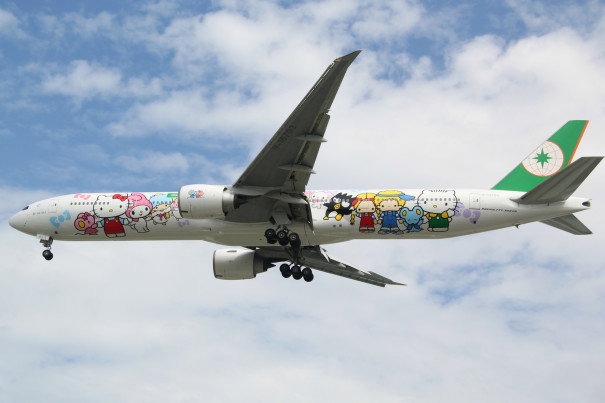
Having a Glass (Or More?) of Wine on a Hello Kitty‑Themed Plane

Having a Glass (Or More?) of Wine on a Hello Kitty‑Themed Plane
White Wine on EVA Air
It began at the boarding gate: a gasp of pink within Taipei’s otherwise depressing Taoyuan International Airport. Though I had heard of EVA Air’s special Sanrio-themed flights, my boarding pass for flight 160 to Seoul, printed earlier that day at Tokyo’s Narita Airport, was sadly Hello Kitty-less. Here at the gate, though, all was pink, and decorated with half a dozen murals: Hello Kitty and friends throwing a picnic, Hello Kitty and friends observing a dragon dance, Hello Kitty and friends eating mooncakes beneath a starry sky.
Cuteness often gets a bad rap. We assume the infantile, the emotional, the weak; once on board the airplane, we were surrounded by a riot of cute. A short video, depicting Hello Kitty celebrating the upcoming Lunar New Year, played on the seatback’s entertainment system, while a pink bow topped the safety instruction sheet and decorated the seat coverings and pillows. A clear generational divide began to emerge: any passenger under the age of roughly thirty, myself included, was too busy taking photos to notice the rather bewildered expressions of our older traveling companions.
I read the pamphlet tucked away in the seatback in front of me as my neighbors, an elderly couple and a middle-aged woman I assumed was their daughter, played musical chairs. Hello Kitty, I learned, lived in London, and had a boyfriend named Dear Daniel and a twin sister named Mimsy. (The mythology had expanded since I was in the second grade.) This flight, one of seven Hello Kitty-themed flights operated by the airline, was known as the Hello Kitty Apple Jet, named so after the measuring system used in the Sanrio world. Hello Kitty, as it turned out, stood five apples tall and weighed a grand total of three apples; “How many apples are you?” asked the pamphlet, innocently enough.
Disturbed by the sheer number of apples I weighed in comparison, I quickly set the pamphlet down. We were now in the air, and a few weary flight attendants were making the drink rounds, each clad in pink aprons emblazoned with Hello Kitty’s face. “White wine,” the woman next to me asked, and gulped it down with a ferocity found only in those traveling with their families. She noticed me taking a photo of the Hello Kitty moist towelette and, perhaps emboldened by her free wine, asked me if I was a fan.
“Oh, definitely,” I said. “She reminds me of my childhood. I used to own a lot of Hello Kitty stuff, and this flight is making me really happy. Are you a fan?”
“No,” she laughed. “But she is very cute.”
She asked me why I was going to Korea (for Seollal, the New Year). I asked her where she was coming from (Singapore, a vacation with her parents). I asked her if she had enjoyed her travels; “Oh,” she said, and rubbed her temples as beside her, her parents bickered in Korean. We laughed, and when our flight attendants distributed our meals (complete with Hello Kitty utensils and vegetable garnishes cut into the shape of bows), I asked for some white wine of my own.
“Bon appetit,” I said, raising my plastic glass towards her. She furrowed her brow.
“What does that mean?”
Sometimes language fails us. I could tell my explanation, that this was a French phrase we also often used in the U.S. before a meal, sounded nonsensical; nevertheless, she raised her glass and wished me “Bon appetit” as well. As we ate, her parents argued. A girl in the aisle near us tried to convince a flight attendant to give her a pink apron. So often cuteness is regarded as immature, the domain of the very young or young-minded, but there’s something comforting to it, as well. Instead, an alternate viewpoint: cuteness as a means of communication, a refuge from the exhaustions of travel, of family, of day-to-day living. Hello Kitty, indeed.